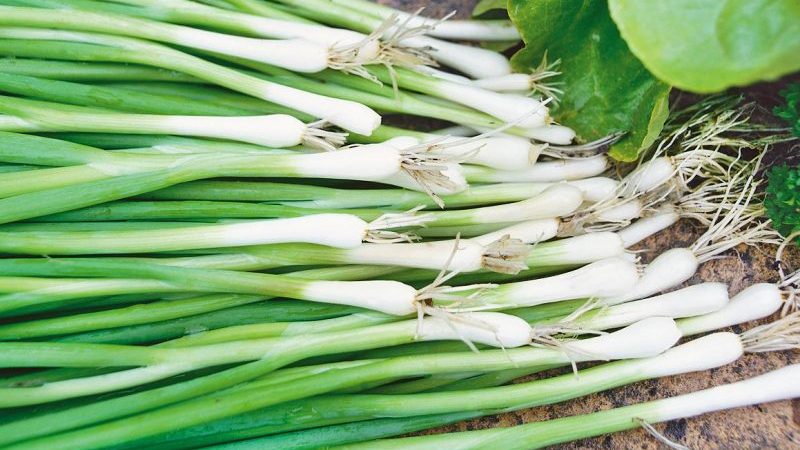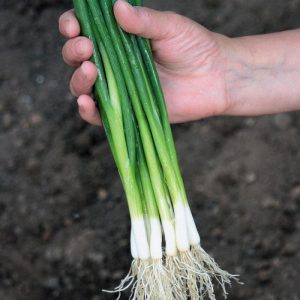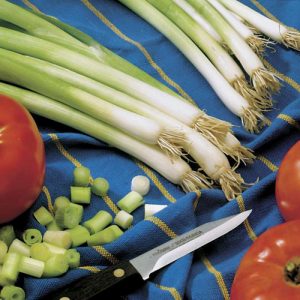High-yielding onion variety with amazing flavor "Parade"
Most often, onions are grown in Russia, paying little attention to the batun. The only exceptions are a few popular varieties, one of which is Parade. Its luscious greens are semi-sharp in flavor and contain a variety of vitamins and minerals. What are the advantages and disadvantages of this onion, what characteristics it can boast of and how to grow it - read below.
The content of the article
Description of the Parade variety
Parade onions do not form bulbs and are grown only for herbs, which are ideal for making salads and as an additive in soups, okroshka, marinades, fish or poultry dishes.
The Parade variety was bred by the Dutch breeders of BEJO ZADEN B.V. It was added to the State Register of Russia in 2000.

Chemical composition, trace elements and vitamins, useful properties
The Parade variety contains:
- vegetable protein, carbohydrates, fats;
- vitamins A, C, E, K, PP, group B;
- amino acids;
- micro- and macroelements: potassium, calcium, phosphorus, magnesium, sodium, zinc, copper, selenium, iron, manganese.
Use this onion has a beneficial effect on metabolism and heart function, helps to eliminate toxins and prevent atherosclerosis. Also onion strengthens the immune system and supports kidney health.
Ripening period and yield
Parade is a mid-early variety; it takes about 60 days from planting to harvest.
This onion is characterized by a high yield - up to 4.2 kg per 1 sq. m.
Disease resistance
Variety Parade is resistant to diseasesaffecting bulbous crops.
Characteristics of the bulb, description of the appearance, taste
Onion Parade is a tall plant, reaching 60 cm in height, with a powerful, erect leaf rosette. Each plant weighs about 50-60 g.
The false stem (white part) is short, the bulbs are not formed, the leaves are cylindrical, grow at the base, green with a blue tint, covered with a thin layer of waxy coating.
Feathers are juicy, delicate, have a pleasant semi-sharp taste and a light garlic aroma.
Reference. The Parade variety does not have any special requirements for the climate and is successfully cultivated in all regions of the country.
Advantages and disadvantages of the Parade variety
Pros of the variety:
- high productivity;
- frost resistance;
- the possibility of growing in open ground and greenhouses;
- long growing season;
- high content of vitamins and minerals.
There are no downsides to this onion, you just need to understand that it does not form bulbs.
Difference from other varieties
Comparison with other varieties of onion-batuna with Parade is presented in the table:
| Variety | Leaf color | Taste | Plant height, cm | Plant weight, g | Productivity, kg / sq. m |
| Parade | Green with a blue tint | Semi-sharp | Up to 60 | 50-60 | 4,2 |
| Tenderness | Green | Weak-sharp | Up to 53 | 50-60 | 4,2-4,6 |
| Perfomer | Bluish green | Weak-sharp | 50 | 55 | 2,5 |
| Capital | Green-blue | Semi-sharp | Up to 55 | 12-16 | 1,8-2,1 |
Features of planting and growing
The peculiarity of the Parade variety is that it can be grown in open ground and greenhouses, using a seedling and non-seedling method.Depending on the method chosen, the onion requirements for the timing and rules of planting also differ. The seedling method is more often used in the northern regions.
Preparing for landing
When planting onions directly into open ground, pre-processing of the planting material is not required. In the case of sowing seeds for seedlings, they are soaked for a day in a solution of a growth stimulator, for example, "Epina", for speedy germination.
 The beds, including in the greenhouse, are dug deeply in the fall and up to 10 kg of organic fertilizers, as well as phosphorus and potassium, are added to the ground. In the spring, before landing, the soil is enriched with nitrogen (30-40 g per 1 sq. m).
The beds, including in the greenhouse, are dug deeply in the fall and up to 10 kg of organic fertilizers, as well as phosphorus and potassium, are added to the ground. In the spring, before landing, the soil is enriched with nitrogen (30-40 g per 1 sq. m).
When growing seedlings in boxes, the soil is first disinfected - spilled with a 2% manganese solution and covered with a dark film. After a week, the film is removed, the soil is fertilized with potassium chloride (15 g) and superphosphate (20 g) per 1 sq. m of boxes put together.
Ground requirements
The variety grows well and gives a bountiful harvest in any soil. At the same time, he still prefers a light, rich in organic matter soil with good moisture and air permeability and an acidity level of pH 6-7.
Predecessors
It is best to plant Parade onions after cucumbers, tomatoes, potatoes or legumes.
Timing, scheme and landing rules
For seedless growing of onions in the open field, sowing seeds is carried out in early May.
Landing scheme:
- Dig up the bed by adding nitrogen fertilizers to the ground (40 g per 1 sq. M).
- Level the soil and make grooves with a maximum depth of 1.5 cm at a distance of 15-20 cm from each other.
- Sprinkle them with sand or chalk and sow seeds every 5 cm.
- Sprinkle the seeds with earth, water a little and cover the beds with a non-woven cloth, which is removed after the seeds germinate.
In the case of planting onions for seedlings, pre-soaked seeds are sown in early or mid-March, observing the following scheme:
- Prepare 60 cm x 40 cm wooden or plastic boxes with nutrient soil.
- Make grooves in it 1 cm deep, the distance between which should be 5 cm.
- Spray them with warm water.
- Sow seeds in the grooves, deepening by a maximum of 1 cm, sprinkle with earth and spray again with water.
- Cover the boxes with seeds with polyethylene and put them in a bright place at a temperature of + 18… + 25 ° C.
- After emergence, remove the foil and move the boxes to a cooler place at a maximum temperature of + 16 ° C.
Crops must be regularly watered and fed once every 10-14 days with organic and mineral fertilizers. At the end of May, when the frosts have completely receded, the seedlings are transplanted into the beds.
Growing features
To achieve the highest possible yield, you need to plant onions in areas well-lit by the sun, protected from the wind.
In the greenhouse, the air temperature before germination should be at least + 22 ° C during the day and approximately + 18 ... + 20 ° C at night. When sprouts appear, the temperature is lowered for a week to + 12 ... + 15 ° C, and then it is maintained at + 20 ° C.
The lighting inside the greenhouse can be varied at first, but a few weeks after sprouting, the onions need to be illuminated around the clock, otherwise the greens will be too thin and pale.
Onion care consists in watering, weeding, loosening and feeding. It is important to consider that there are some differences in planting care depending on the growing location.
Watering mode
Parade has small roots, so watering is especially important for him. The soil is moistened about once a week, making sure that the soil does not dry out more than 3-5 cm deep.
Loosening the soil and weeding
Weeds take nutrients from the soil, which negatively affects the growth and development of onions. Therefore, the beds are regularly weeded, getting rid of weeds. Weed growth can be prevented by mulching the row spacings with straw, sawdust or agrofibre.
Also, the soil is loosened 1-2 days after watering - this helps to improve oxygen access to the roots.
Top dressing
Onions grown outdoors are fed for the first time when the weather is stable. Plants are watered with infusion of weeds and other herbs, pre-soaked for 2-3 days in 10 liters of warm water.
When 3-5 feathers appear on the sprouts, the soil is fertilized with potassium and phosphorus: 1 tbsp each is dissolved in 10 liters of water. l. fertilizers and spill the soil with the resulting solution. The same feeding is required when the plants have 8 leaves.
Important! The plants are fed in the morning in dry weather, making sure that the fertilizer does not get on the feathers.
In the greenhouse, top dressing is applied as needed. If the feathers turn pale and become thinner, the plants are watered with urea or "Kristallon" diluted in 10 liters of water (15 g each).
Disease and pest control
The variety has good immunity and, subject to the rules of agricultural technology and crop rotation, is practically not affected pests and diseases. Otherwise, there is a risk of developing downy mildew, Alternaria, gray mold and attacks of onion flies and ticks.
At the first signs of damage to plantings, they are treated with fungicides and insecticides.
Important! You can eat onion feathers at least three weeks after being treated with chemicals.
Growing difficulties
In the process of growing Parade, some problems may arise:
- The onion hibernates when the air temperature rises to + 27 ° C. To stimulate growth, it must be watered with cool water.
- Drying of the green part and, in general, poor development of plants with insufficient watering.
- Damage by pests when onions grow nearby.
Harvesting and storage
Parade is a variety of onions that can be harvested several times per season, and when grown in heated greenhouses, throughout the year.
How and when to collect
The first crop is harvested in the middle of summer, by pulling the onions out of the ground by the roots or cutting off the feathers. You can cut the onion 3-4 times per season with an interval of about 38-50 days.
Storage features and keeping quality of the variety
The cut greens are wrapped in cling film, making small holes in it for ventilation, and stored in the refrigerator. In such conditions, onions retain their qualities for a month.
Tips from experienced gardeners
Farmer recommendations for growing Parade:
- Water the onions regularly. This variety can tolerate short-term drought, but it is better not to allow this.

- Burn all plants affected by diseases or pests away from the site.
- Spill the soil with boiling water before planting seeds. This helps to get rid of some fungi and pests.
- Water the plants in the morning, not in the evening, otherwise they will not have time to dry, and the accumulation of moisture will lead to the multiplication of bacteria.
- Do not plant onions nearby. He is often attacked by onion flies, which can switch on Parade.
Reviews of the Parade onion variety
Most gardeners are satisfied with the cultivation of Parade onions, which is confirmed by their positive reviews about this variety.
Pavel, Tver: «I grow onions not only for myself, but also for sale, so I choose the varieties especially carefully and scrupulously. The parade suits me completely: the harvest is large, you can cut the greens 3 times a season, the feathers are juicy and beautiful. "
Valentina, Belgorod region: “Our family loves feathers more and more than bulbs, so we hardly plant onions. Among the varieties grown for the sake of greenery, we stopped at the Parade, because it combines all the main advantages - a pleasant taste, quick germination and a bountiful harvest. We have a small plot, but even one bed of this onion is enough for fresh herbs to always be on the table. "
Conclusion
Parade is a mid-season onion variety successfully cultivated in all regions of Russia. The breeders managed to consolidate in it resistance to shooting, diseases and pests, which, combined with other positive characteristics, such as simplicity in care and a pleasant taste, made it one of the most popular varieties of batuna onions.